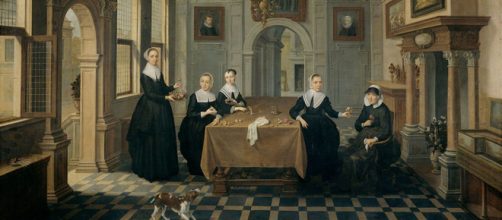What's wrong with this picture? "Female Power," Rijksmuseum's new painting show, is getting advanced on its website with an image that conjures up women forced to live as concubines in the TV series "The Handmaid's Tale."
The painting, a 17th-century work titled "Five Women in an Interior," Northern Netherlands by Dirck van Delen, shows the figures in headdresses like those stark white bonnets seen in Hulu's dystopian tale of a totalitarian theocracy.
Based on Margaret Atwood's 1985 novel, the television series describes how patriarchy divides females into castes according to their usefulness to the state.
Of course, the bonnets in the TV show are fiction by costume designer Ane Crabtree and have nothing to do with the picture on exhibit at Rijksmuseum.
A distinction without a difference
Crabtree has freely acknowledged that the head coverings are a mix of religious dress, native dress, and her imagination. I think there's a shade of Mennonite bonnets in the mix, too. But no matter what the frame of reference, female power doesn't enter the picture. It's too late in the day to call it that. (More about that in a moment).
It goes without saying that the Rijksmuseum should have chosen a better promotional image to convey the theme of strong women from the 17th, 18th, and 19th centuries - including paintings from female artists.
So, why not picture one of those on the website?
According to exhibit literature, "each of the women has a unique story testifying to their willpower, vision, and courage." Where was Rijksmuseum's courage? One story that exhibit artist Rachel Ruysch could tell is how this 136-year-old institution ignored her until this past March when it hung her work in a Dutch Masters show.
Long day's journey
The Rijksmuseum has been chronicling the 800-year story of Dutch art since 1885, but only this year did it think to hang women's work in its touted Gallery of Honor alongside the likes of Rembrandt.
A painting of Salome is also included in the promotion of "Female Power." And its "portrayals of strong women" is a painting of Salome.
But wasn't she the one who had John the Baptist beheaded? If you're going to include murderesses to make a point about strong women, some biggies are missing.
I'm thinking of a painting by Dutch artist Anthonie Blocklandt van Montfoort's portrait of Countess Elizabeth Bathory, who persuaded her husband Count Ferencz Nádasdy to build a tortures chamber in their castle. The Guinness Book of Records credits her for committing the most murders – some 650 victims. Talk about female power.
About that. Isn't equality rather than power what female artists want? Or is the Rijksmuseum overstating the show's theme to compensate for long under-acknowledging the part that women artists played in Dutch art history?
Since this museum of Dutch art opened so many decades ago, why only this year did it think to put women's art in its "Gallery of Honor"? And why only this year did it initiate a "multipronged research into the role of women in Dutch culture"? Far from praiseworthy, this is a case of what took this place so long?
According to Rijksmuseum, part of this research is "finding more detailed information about the women depicted in the paintings." Really? Has no one yet come upon info about Salome? For a quick study, check out the 2013 flick with Jessica Chastain as Salome.


